Serving 1,096 students in grades Prekindergarten-5, Bunnell Elementary School ranks in the bottom 50% of all schools in Florida for overall test scores (math proficiency is bottom 50%, and reading proficiency is bottom 50%).
The percentage of students achieving proficiency in math is 49% (which is lower than the Florida state average of 52%). The percentage of students achieving proficiency in reading/language arts is 49% (which is lower than the Florida state average of 52%).
The student:teacher ratio of 13:1 is lower than the Florida state level of 17:1.
Minority enrollment is 40% of the student body (majority Black), which is lower than the Florida state average of 65% (majority Hispanic).
Quick Stats (2025)
- Grades: Prekindergarten-5
- Enrollment: 1,096 students
- Student:Teacher Ratio: 13:1
- Minority Enrollment: 40%
- Overall Testing Rank: Bottom 50% in FL
- Math Proficiency: 49% (Btm 50%)
- Reading Proficiency: 49% (Btm 50%)
- Science Proficiency: 35-39% (Btm 50%)
- Source: National Center for Education Statistics (NCES), FL Dept. of Education
Top Rankings
Bunnell Elementary School ranks among the top 20% of public schools in Florida for:
Category
Attribute
Student Attention
School Overview
Bunnell Elementary School's student population of 1,096 students has declined by 6% over five school years.
The teacher population of 83 teachers has stayed relatively flat over five school years.
Grades Offered
Grades Prekindergarten-5
(No virtual instruction)
(No virtual instruction)
Total Students
1,096 students
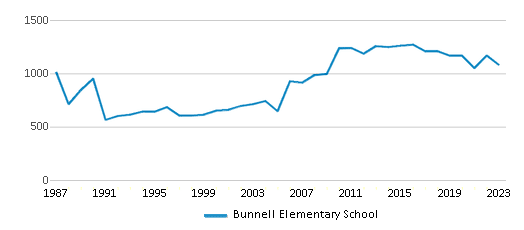
Gender %

Total Classroom Teachers
83 teachers
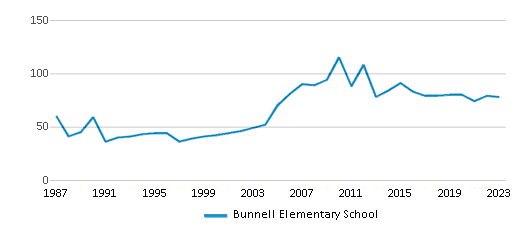
Students by Grade

School Calendar
School Rankings
Bunnell Elementary School ranks within the bottom 50% of all 3,704 schools in Florida (based off of combined math and reading proficiency testing data).
The diversity score of Bunnell Elementary School is 0.59, which is less than the diversity score at state average of 0.70. The school's diversity has stayed relatively flat over five school years.
Overall Testing Rank
#1990 out of 3704 schools
(Bottom 50%)
(Bottom 50%)
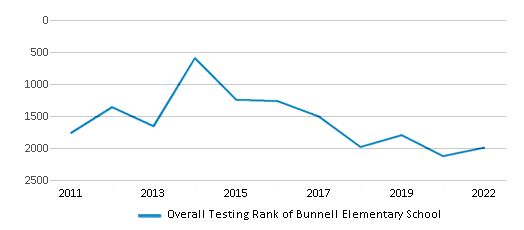
Math Test Scores (% Proficient)
49%
52%
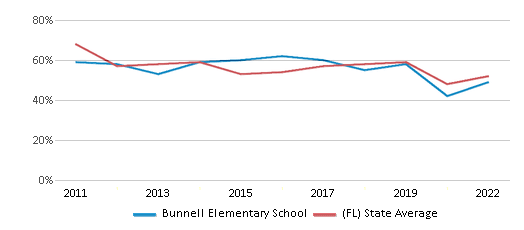
Reading/Language Arts Test Scores (% Proficient)
49%
52%

Science Test Scores (% Proficient)
35-39%
52%
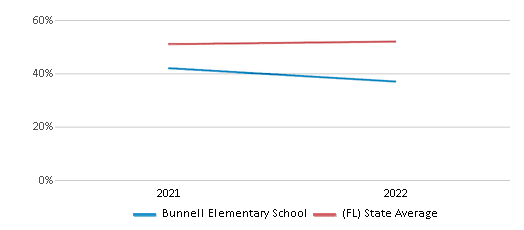
Student : Teacher Ratio
13:1
17:1

American Indian
n/a
n/a
Asian
2%
3%

Hispanic
13%
37%
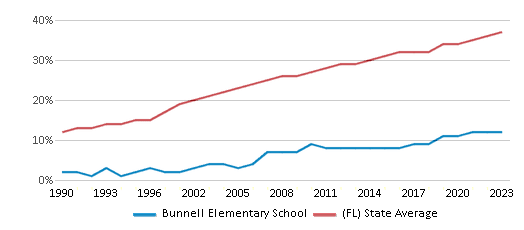
Black
18%
21%
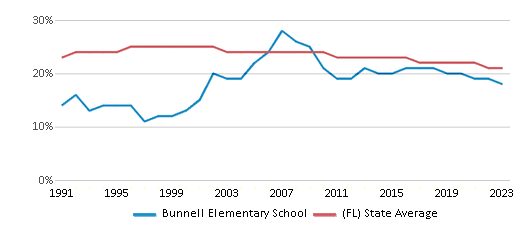
White
60%
35%
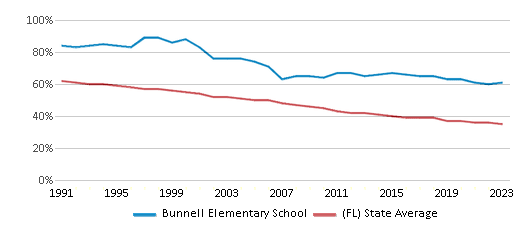
Hawaiian
n/a
n/a
Two or more races
7%
4%
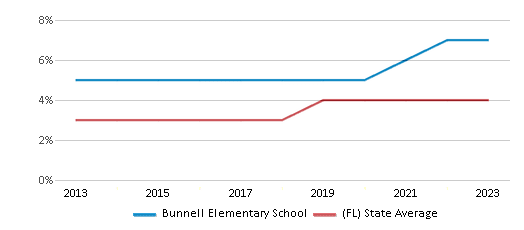
All Ethnic Groups
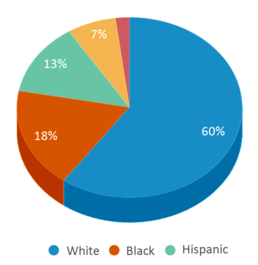
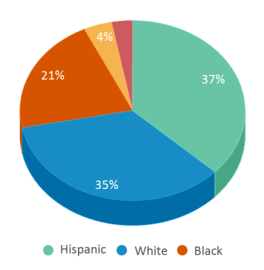
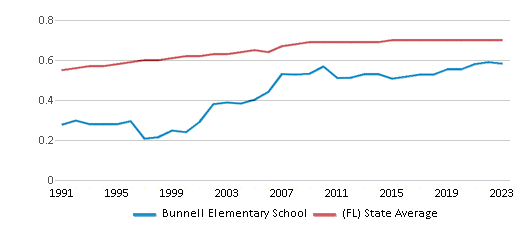
Participates in the National School Lunch Program (NSLP)
Yes
Eligible for Free Lunch
64%
47%
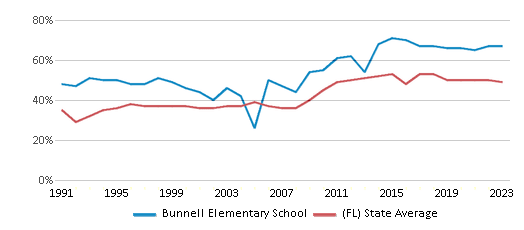
Eligible for Reduced Lunch
6%
4%
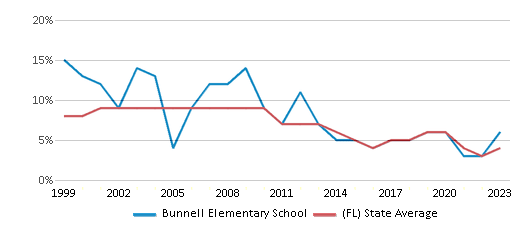
School Statewide Testing
School District Name
Source: National Center for Education Statistics (NCES), FL Dept. of Education
Profile last updated: 02/09/2025
Frequently Asked Questions
What is Bunnell Elementary School's ranking?
Bunnell Elementary School is ranked #1990 out of 3,704 schools, which ranks it among the bottom 50% of public schools in Florida.
What schools are Bunnell Elementary School often compared to?
Bunnell Elementary Schoolis often viewed alongside schools like Old Kings Elementary School by visitors of our site.
What percent of students have achieved state testing proficiency in math and reading?
49% of students have achieved math proficiency (compared to the 52% FL state average), while 49% of students have achieved reading proficiency (compared to the 52% FL state average).
How many students attend Bunnell Elementary School?
1,096 students attend Bunnell Elementary School.
What is the racial composition of the student body?
60% of Bunnell Elementary School students are White, 18% of students are Black, 13% of students are Hispanic, 7% of students are Two or more races, and 2% of students are Asian.
What is the student:teacher ratio of Bunnell Elementary School?
Bunnell Elementary School has a student ration of 13:1, which is lower than the Florida state average of 17:1.
What grades does Bunnell Elementary School offer ?
Bunnell Elementary School offers enrollment in grades Prekindergarten-5 (No virtual instruction).
What school district is Bunnell Elementary School part of?
Bunnell Elementary School is part of Flagler School District.
School Reviews
2 10/16/2014
I have never been more infuriated with a school's staff, in my life. My child has mild Autism and requires therapy... Well, for some reason she has yet to receive therapy of any kind (two months later). What's a Mom to do when you can't get into the school, to speak to anyone, unless you have an appointment, but nobody will call/email you back to make an appointment.. Nobody will speak to you, except the teacher, but she can't do anything about it.. It took me, her therapists, and teachers three years of hard work, to get my child on track and ready for school ON TIME.. But with the lack of help from this school's staff she's, already, behind.. My child's education is NOT a joking matter and I am sick to death with being treated disrespectfully every time I have an interaction with a staff member at this school. I have never felt defeated as a Mother, until my child started kindergarten, this year.. Never thought I would have to relocate, into another county, in order to feel comfortable with her going to school. SHAME ON YOU STAFF MEMBERS! I only gave the one star because of the teacher my Daughter has. She is a wonderful woman, and great teacher.
Review Bunnell Elementary School. Reviews should be a few sentences in length. Please include any comments on:
- Quality of academic programs, teachers, and facilities
- Availability of music, art, sports and other extracurricular activities
Recent Articles

School-to-Prison Pipeline Persists Despite Local, State and National Efforts
Inadequate funding and resources for schools, harsh zero-tolerance discipline policies, police presence in public schools, and de facto segregation continue to create school environments in which poor and minority students have little chance of succeeding. The result is a continuation of the school-to-prison pipeline that has been commonplace in the American education system for decades, despite federal, state and local efforts to curb the problem.

How the Arts Benefit Your Children Academically and Behaviorally
Often underfunded in the past, the arts are gaining a resurgence in support as research shows benefits for children academically, along with improvements in behavior and attendance.

February 05, 2025
Understanding the U.S. Department of Education: Structure, Impact, and EvolutionWe explore how the Department of Education shapes American education, from its cabinet-level leadership to its impact on millions of students, written for general audiences seeking clarity on this vital institution.









